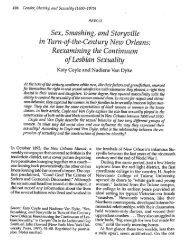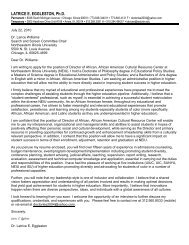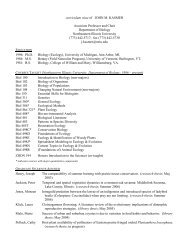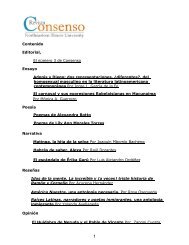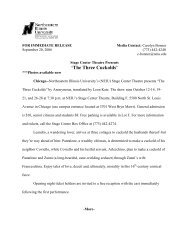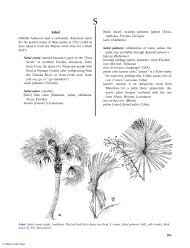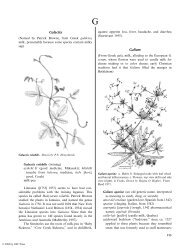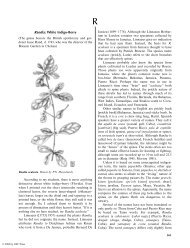Herba Cana - Northeastern Illinois University
Herba Cana - Northeastern Illinois University
Herba Cana - Northeastern Illinois University
Create successful ePaper yourself
Turn your PDF publications into a flip-book with our unique Google optimized e-Paper software.
© 2004 by CRC Press<br />
The Ethnobotany 519<br />
Antilles), griffe-chatte (cat’s claw, Dominique, Martinique),<br />
or bois crabbe (crabwood, French Antilles).<br />
People have some wonderfully obtuse ways of<br />
cursing these plants. They may be the arranca pellejo<br />
(skin puller, Venezuela), the beshi di Juana (Jane’s kiss,<br />
Dutch Antilles), bois traînant (dragging tree, Dominique,<br />
Martinique), manca montero (wild impediment,<br />
Cuba), rolón (enveloper, Puerto Rico), or the rolón<br />
escambrón (scaly enveloper, Puerto Rico). To others,<br />
they are avaramo (Brazil) because they resemble the<br />
avará or Arecastrum palm, both notably spiny. They<br />
might be escambrón colorado (big red scale), espino de<br />
mar (sea spine), espino de playa (beach spine, Nicaragua),<br />
or the espinuelo (spiny one, Venezuela). Nevertheless,<br />
everyone’s view after being caught in the claws<br />
and branches of this plant is that it is the diaballe<br />
(devil, Martinique).<br />
Linnaeus ([1753] 1957) captured the bristly nature<br />
of the tree when he called it Mimosa unguis-cati (cat’s<br />
claw mimosa). He knew the plants from the botanical<br />
garden in Uppsala, Sweden, and from Sloane’s<br />
Jamaican herbarium specimen. However, the species<br />
ranges from southern Florida, through the Bahamas,<br />
the West Indies, and Mexico (Tamaulipas and Sinaloa)<br />
south through Central America to Bonaire and<br />
Curaçao, Venezuela, and Guyana. Throughout its<br />
range, everyone has used the plants. The wood is clear<br />
brown, hard, and heavy, and has been used by all who<br />
know it, especially in construction (Morton 1981). The<br />
fruit yields a yellow dye.<br />
The Spaniards apparently thought that the black<br />
seeds resembled the kidneys and the immature white<br />
aril the fat surrounding them. Therefore, by the<br />
Doctrine of Signatures, they concluded that the plant<br />
was good to treat kidney problems. Some think the<br />
Spaniards started using the bark and fruits to treat<br />
kidney problems, but people who preceded them in the<br />
Americas had used the plants long before Europeans<br />
arrived. Since the bark and fruit are rich in tannin and<br />
astringent, they had been used to treat bronchitis,<br />
chronic diarrhea, and hemorrhaging for generations<br />
(Standley 1920 /1926, Roig 1945, Mors et al. 2001).<br />
The bark was also considered tonic and diuretic and<br />
was used to treat fever, and to cure chronic sores.<br />
During early European history the plant in Jamaica<br />
was considered the ‘‘sovereign medicine for the stone<br />
and gravel,’’ and also for the liver and spleen (Standley<br />
1920 /1926). In Curaçao the leaf decoction is taken to<br />
relieve colds (Morton 1981).<br />
The related species, P. keyense (of the Keys), is<br />
similarly rich in tannins, and is used to stop bleeding.<br />
In the Bahama Islands, leafy twigs are chewed or<br />
made into a ‘‘tea’’ to stop bleeding 3 or 4 months into<br />
pregnancy (Morton 1981). That species, easily confused<br />
with P. unguis-cati, is also known as black bead<br />
(Florida, Bahamas), ram’s horn (Bahamas), or aroma<br />
(Bahamas).<br />
People consider the aril edible, but some are sweet<br />
and others are astringent. Perhaps if they are eaten<br />
while still white they would be tastier, but those I have<br />
tried were red, in fully open fruits, and tasted too<br />
much like alum. Seeds are still strung into necklaces<br />
and rosaries as they were in Sloane’s time.<br />
The most famous member of the genus is the<br />
American P. dulce. That species is most often known<br />
under some variation of the Náhuatl name quauhmochitl<br />
(snake jaws), including huamúchil, cuamúchil,<br />
guamúchil, quamochitl, guamuche, camanchil, camonsil,<br />
and camachile. While the plant was first recorded by<br />
Hernández in 1651, the connection between the name<br />
and the plants carried around the world by the<br />
Spanish remained unknown for centuries. Indeed,<br />
the vagaries of where a plant is first collected and<br />
reported as new to science are unpredictable. Pithecellobium<br />
dulce was described in 1795 from the Coast<br />
of Coromandel in India, and for decades people<br />
thought it was native to the Old World. Then it was<br />
discovered that it had been taken there by the Spanish,<br />
first to the Philippines, and then to mainland Asia<br />
(Standley 1920 /1926).<br />
Since no chemical studies have been found for P.<br />
unguis-cati or P. keyense, the best that can be done is<br />
to compare it with congeners. Pithecellobium dulce<br />
contains tannins (Steynberg and Hemingway 1994),<br />
triterpene glycosides (Yoshikawa et al. 1997, Nigam et<br />
al. 1997), triterpene saponins (Sahu and Mahato<br />
1994), and vernolic, malvalic, and sterculic acids<br />
(Hosamani 1995). An Indonesian species contains<br />
flavan-3-ol gallates and proanthocyanidins (Lee et al.<br />
1992). Triterpene saponins are anti-inflammatory<br />
(Sahu and Mahato 1994), triterpenoid glycosides<br />
are antifungal (Khan et al. 1997), and other compounds<br />
are antimicrobial (Ali et al. 2001). Related<br />
species P. saman and P. mangense yield gum exudates<br />
(Leon De Pinto et al. 1995), and P. saman contains<br />
saponins similar to those in P. dulce (Varshney et al.<br />
1985).<br />
Pithecellobium flexicaule produces seeds that are<br />
consumed in northeastern Mexico (Alanis Guzman et<br />
al. 1998) and that have been used in afforestation in<br />
Texas (Vora and Labus 1988). Related species have<br />
uses like P. unguis-cati and maybe similar chemicals.<br />
Sometimes Florida common names are specific:<br />
P. keyense is blackbead and P. unguis-cati is catclaw.<br />
Nowhere else in their range are they distinguished, and<br />
botanists did not even separate the two until<br />
P. keyense was described in 1928. However, a small<br />
gall-wasp (Tanaostigmodes pithecellobiae) uses only P.<br />
keyense and ignores P. unguis-cati (Weekley





